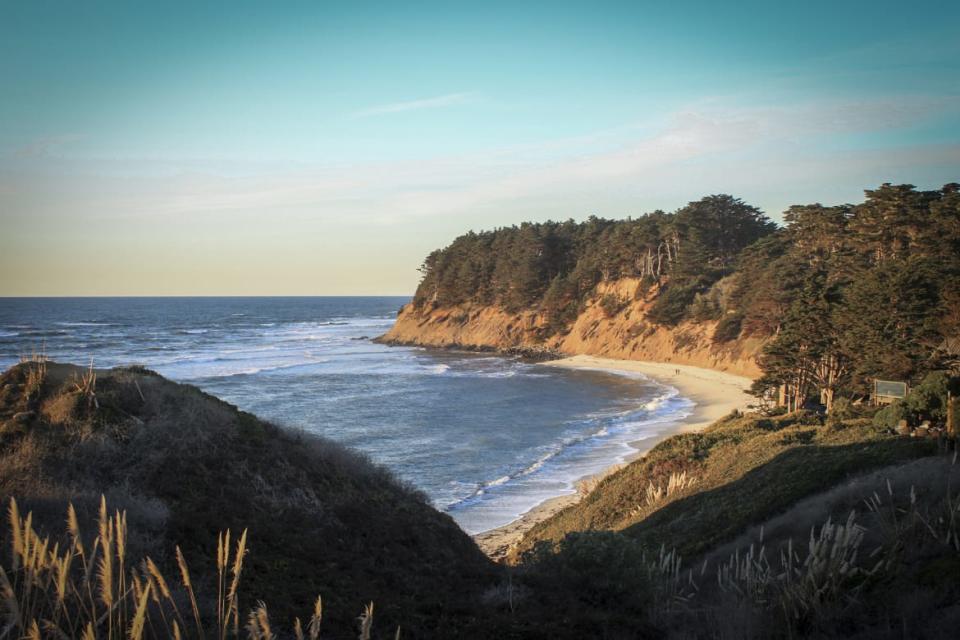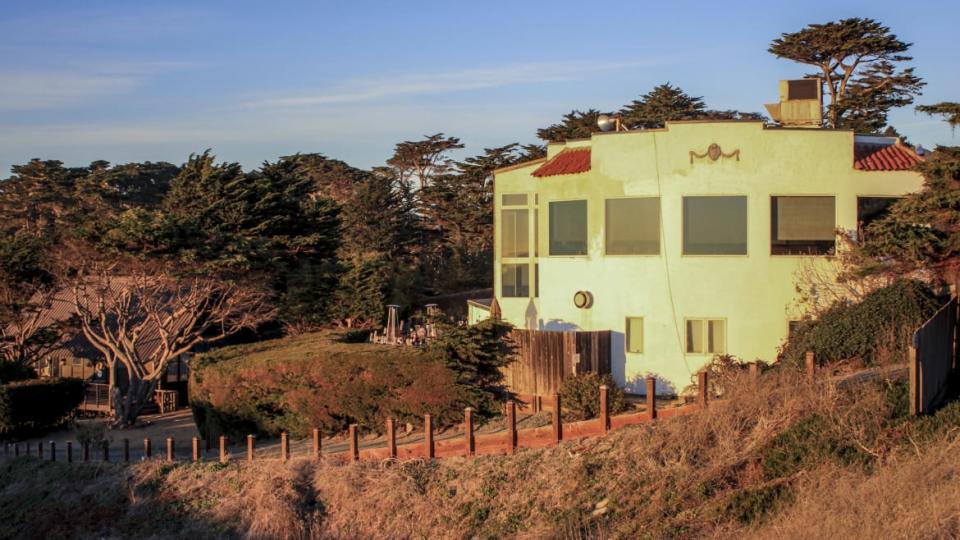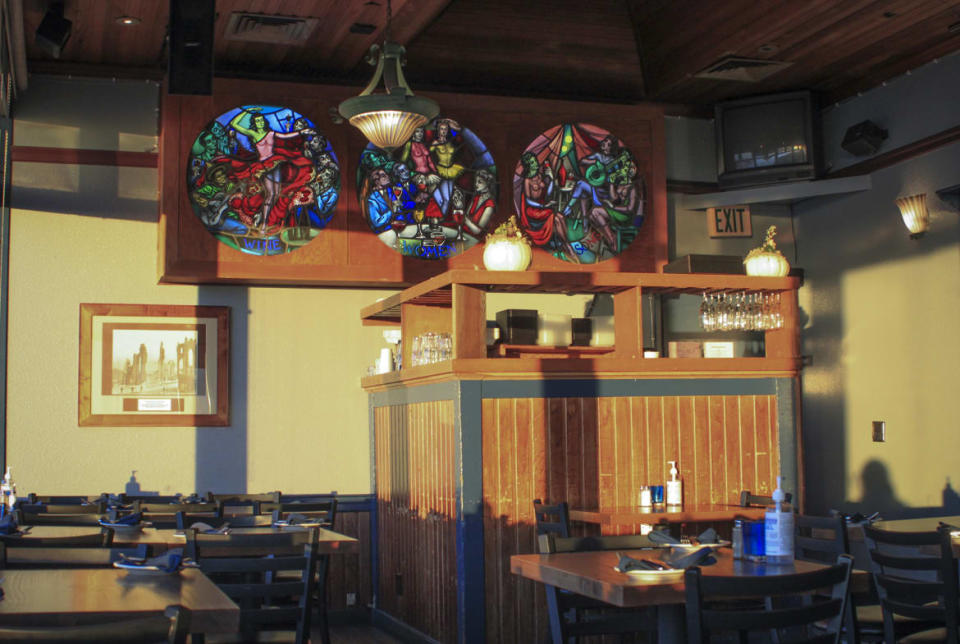The Haunted California Bar With a Killer View—and Criminal Past

It is not the celebrity ghost that brings us up to the Moss Beach Distillery near Half Moon Bay. The cliffside view alone is worth the 50-mile drive from Santa Cruz, a seaside city not lacking in inspiring vistas. The kitchen offers a well-executed northern California surf ’n’ turf of fried artichokes, fish tacos, seafood sliders, pastas and more that put other local eateries to shame. Then there’s the intimate art deco bar and its tuck ’n’ roll swivel stools occupied by chatty locals in flannel shirts and hoodies, and the curious ceiling fresco of a matador spiking a bull. The place is laid-back panache, a legendary northern California bar and grill that doesn’t need a ghost to put it on the map, but has one all the same.
The Blue Lady is a local personality featured in stacks of newsprint and television, most notably a 1992 Unsolved Mysteries episode hosted by Robert Stack, renowned for his portrayal of Elliot Ness, Chicago’s “untouchable” whiskey barrel-smashing G-man. There are several versions of her story, all of which take place during Prohibition and involve a love triangle between her, a piano player, and her husband, and ends in the flapper’s violent death.
Crimes of passion make for good tales, although there is no historical record of such a murder at Moss Beach. There were, however, many other crimes committed in the area during the roaring ’20s, when small-time racketeers became criminal syndicates and the Moss Beach Distillery was the cat’s pajamas of local roadhouses known then as Frank’s Place.
Before Prohibition, San Mateo County (San Francisco’s southern peninsula) was a rural stretch of wild coast scattered with artichoke and Brussel sprout farms while pines and sequoias were lumbered in the mountains above. Plans to turn beachside Half Moon Bay areas into resorts petered out when a coastline railway project was canned, leaving city-dwellers some 30 miles away with only the precarious Pedro Mountain Road as a direct link.

The 18th Amendment, which in 1919 outlawed the manufacture, sale, or transportation of liquors, turned these sleepy communities into playgrounds of vice as rumrunners and bootleggers exploited the isolation and hidden coves along the coast for clandestine deliveries of alcohol while entrepreneurs took advantage of the handy supply of smuggled booze and opened beachside speakeasies. South Bay mobster Sam Termini considered San Mateo County the most corrupt in the state.
The Coast Guard only had two steam cutters to patrol the central California coast, which one state senator called a “smuggler’s paradise.” Most booze came down from Vancouver, though in his book Rum War at Sea, Coast Guard Commander Malcolm Willoughby wrote of a British steamer from Scotland loaded with 25,000 cases of Scotch that anchored outside Half Moon Bay for seven months while contact boats hauled liquor off and supplies back on. He noted that when “a particular official on duty found it profitable to be unobserving,” 15,000 cases cruised through the Golden Gate unmolested.
“The dope is that half the booze put ashore by the Pacific rum fleet is put ashore in Half Moon Bay,” Dashiell Hammett wrote in his 1924 story, “The Girl With The Silver Eyes.” Hammett, a notorious boozer, would know. He spent much of the Prohibition era writing about the adventures of the Continental Op from his San Francisco home on 891 Post Street and was a patron of Frank’s Place, which he fictionalized in the story as the White Shack.
“It’s a tough hole. Run by ‘Tin Star Joplin’, an ex-yegg who invested his winnings in the place when Prohibition made the roadhouse game good. He makes more money now than he ever heard of in his piking safe-ripping days. Retailing liquor is a side-line with him; his real profit comes from acting as a relay station for the booze that comes through Half Moon Bay for points beyond…”

The story may not be Hammett’s finest but writing in the New Yorker, Claudia Roth Pierpont asserts that it laid the foundations for film noir in which “the Op confronts head on the destruction a woman can wreak.” The silver-eyed femme fatale was responsible for two deaths: one in the White Shack parking lot and the other on the road leaving it—a brutal death where a local snitch puts himself in front of the Op’s car to protect the beautiful dame and ends up roadkill. If the Moss Beach Distillery is the perfect scene for neo-noir, it’s probably because its real history could have come right off the pages of hard-boiled fiction.
Frank Torres left his native Peru at the tender age of 14 and worked in galleys across the seven seas, honing the cooking skills he would someday be recognized for. Eventually, he disembarked in San Francisco where he cooked in several restaurants throughout the city. After being fined $300 for selling alcohol in 1923, he moved down to Moss Beach, married a native East Coaster named Fanny Lea, and got into the “the roadhouse game” as co-proprietor of the Marine View Tavern. In 1927, he opened his own joint next door, Frank’s Place, on the bluff above the crashing waves. Food and drinks were served upstairs, a roulette wheel and slot machines were played downstairs. Fanny was rumored to run the bordello in adjacent cabins.
Smugglers used the beach below Frank’s to shuttle booze off speedy skiffs through the protection of night and fog. Frank stored his supply in a garage while the remaining cases went to San Francisco, considered the second wettest city in the country after New York. Local historian, June Morrall, noted an incident a day before New Year’s 1926 when smugglers unloaded a shipment of 4,000 cases of liquor on Moss Beach to much celebration. They had paid $3,000 for information about an 18-agent raid that would occur hundreds of miles away in Weed that day.
Among noteworthy speakeasies in the Half Moon Bay area were the Patroni House, Montara Family Club, Ocean Beach Hotel and Chateau LaFayette–all of which were no strangers to raids. In 1921, police confiscated $50,000 ($745,000 in today’s value) worth of alcohol at the Mori Point Inn, one of the largest busts in the county. Torres, however, never worried about raids. Local and state politicians were regular patrons, including the Sheriff of San Mateo county and Colonel George White of the Prohibition Agency, who guaranteed whiskey would be returned in the event of a raid. William Randolph Hearst knocked drinks back at Frank’s, as did Charlie Chaplin, Mary Pickford, Fatty Arbuckle and other Hollywood elites.

Frank’s Place went legit after repeal of Prohibition in 1933 and maintained an excellent reputation for its fare, being featured in food writer Ruth Thompson’s 1937 book, Eating Around San Francisco. Torres, she noted, “led a life of romance and adventure which makes the lives of ordinary stay-at-homes quite pale beside it.” Frank retired in the 1940s, passing the business to his son Vic who ran it until his death of a heart attack in 1964.
The roadhouse changed hands several times and became the Moss Beach Distillery in the 1970s. Current owner, John Barbour, has maintained the integrity of what is now a historical landmark, having gone so far as to persuade the Torres family to sell him three original hand-painted stained glass pieces Vic had commissioned in the 1940s from San Francisco artist Otto Dressler. He also painted the Haberdasher Coat of Arms at the Hostess stand. Little is known about the matador and bull on the ceiling. It was discovered in 1974 when the owner removed a canvas of dolphins, harps and clovers and had it restored. Supposedly, Frank Torres had once intended to build a bullfighting ring on the premises.
The Blue Lady made her first public appearance in a 1981 San Francisco Examiner interview with new owners, according to journalist Katie Dowd of SFGATE. While ghostly pranks, like trick mirrors, hidden speakers and self-ringing phones have since been revealed, some people insist the place is indeed haunted. During remodeling in the 1970s, a contractor staying in a downstairs room saw an apparition that frightened him so much he bolted back to southern California and never returned to finish the job.
Haunted or not, the Blue Lady isn’t as much a bogeywoman as she is a medium to the likes of Sweet Georgia Brown, Gin Rickeys, and Model Ts. She is a local mascot of an era when eggs and dames knocked on the door of the Moss Beach Distillery back when it was a juice joint and said behind their hands, “tell ’em Joe sent me.”
Get the Daily Beast's biggest scoops and scandals delivered right to your inbox. Sign up now.
Stay informed and gain unlimited access to the Daily Beast's unmatched reporting. Subscribe now.

 money
money 